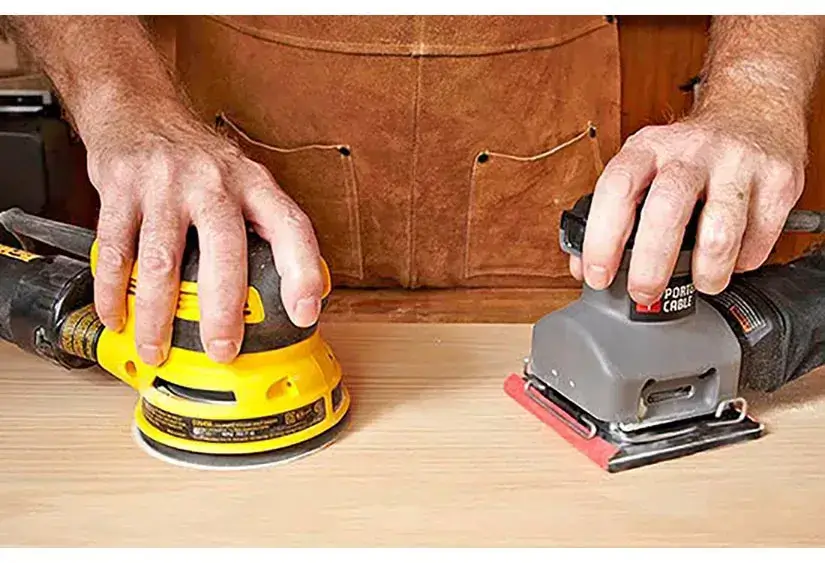If you are looking for a power tool to smooth out rough surfaces, you might be wondering what’s better orbital or palm sander. Both of these tools are commonly used for woodworking, carpentry, and DIY projects, but they have different features and advantages. In this article, we will compare orbital and palm sanders, and help you decide which one is more suitable for your needs.
The Difference Between Orbital and Palm Sanders
The main difference between orbital and palm sanders is the motion of the sanding pad. An orbital sander has a circular sanding pad that rotates and oscillates, creating a random orbital motion. A palm sander has a square or rectangular sanding pad that vibrates back and forth, creating a linear motion.
Orbital sanders are also known as random orbit sanders, because the random motion of the sanding pad prevents swirl marks and scratches on the surface. Palm sanders are also known as sheet sanders, because they use standard sandpaper sheets that are attached to the sanding pad with clamps or hooks.
The Advantages and Disadvantages of Orbital and Palm Sanders
Both orbital and palm sanders have their pros and cons, depending on the type of project and the desired finish. Here are some of the advantages and disadvantages of each tool:
Orbital Sanders
- Advantages:
- They produce a smooth and even finish, without leaving swirl marks or scratches.
- They are more versatile and can be used for a variety of materials, such as wood, metal, plastic, and drywall.
- They are more powerful and can remove more material faster than palm sanders.
- They have variable speed settings that allow you to adjust the sanding speed according to the surface and the grit of the sandpaper.
- They have dust collection systems that reduce the amount of dust and debris in the air and on the surface.
- Disadvantages:
- They are more expensive and heavier than palm sanders.
- They are more noisy and vibrate more than palm sanders, which can cause fatigue and discomfort over time.
- They are not very good at sanding corners, edges, and tight spaces, because the circular sanding pad can damage the adjacent surfaces.
Palm Sanders
- Advantages:
- They are cheaper and lighter than orbital sanders.
- They are more quiet and vibrate less than orbital sanders, which makes them more comfortable and easy to use.
- They are better at sanding corners, edges, and tight spaces, because the square or rectangular sanding pad can fit into narrow areas.
- They use standard sandpaper sheets that are widely available and inexpensive.
- Disadvantages:
- They produce a less smooth and even finish, and can leave swirl marks or scratches on the surface.
- They are less versatile and can only be used for wood and some soft materials, such as plastic and leather.
- They are less powerful and can remove less material slower than orbital sanders.
- They have fixed speed settings that limit the sanding speed to one level.
- They have poor dust collection systems that leave more dust and debris in the air and on the surface.
How to Choose the Right Sander for Your Project
The choice between orbital and palm sanders depends on several factors, such as the size, shape, and material of the surface, the level of smoothness and quality you want to achieve, and your budget and preference. Here are some general guidelines to help you choose the right sander for your project:
- If you are sanding a large, flat, and hard surface, such as a table top, a door, or a floor, you should use an orbital sander, because it will give you a faster and smoother result.
- If you are sanding a small, curved, or soft surface, such as a chair leg, a picture frame, or a leather belt, you should use a palm sander, because it will give you more control and precision.
- If you are sanding a surface that has corners, edges, or tight spaces, you should use a palm sander for those areas, and an orbital sander for the rest of the surface, because it will give you the best of both worlds.
- If you are sanding a surface that has different materials, such as wood and metal, you should use an orbital sander with different grits of sandpaper, because it will give you more versatility and flexibility.
Conclusion
Orbital and palm sanders are both useful tools for smoothing out rough surfaces, but they have different features and advantages. The main difference between them is the motion of the sanding pad, which affects the quality and speed of the sanding process. The best sander for your project depends on the type and size of the surface, the desired finish, and your personal preference. We hope this article has helped you understand the difference between orbital and palm sanders, and how to choose the right one for your needs. Happy sanding!

